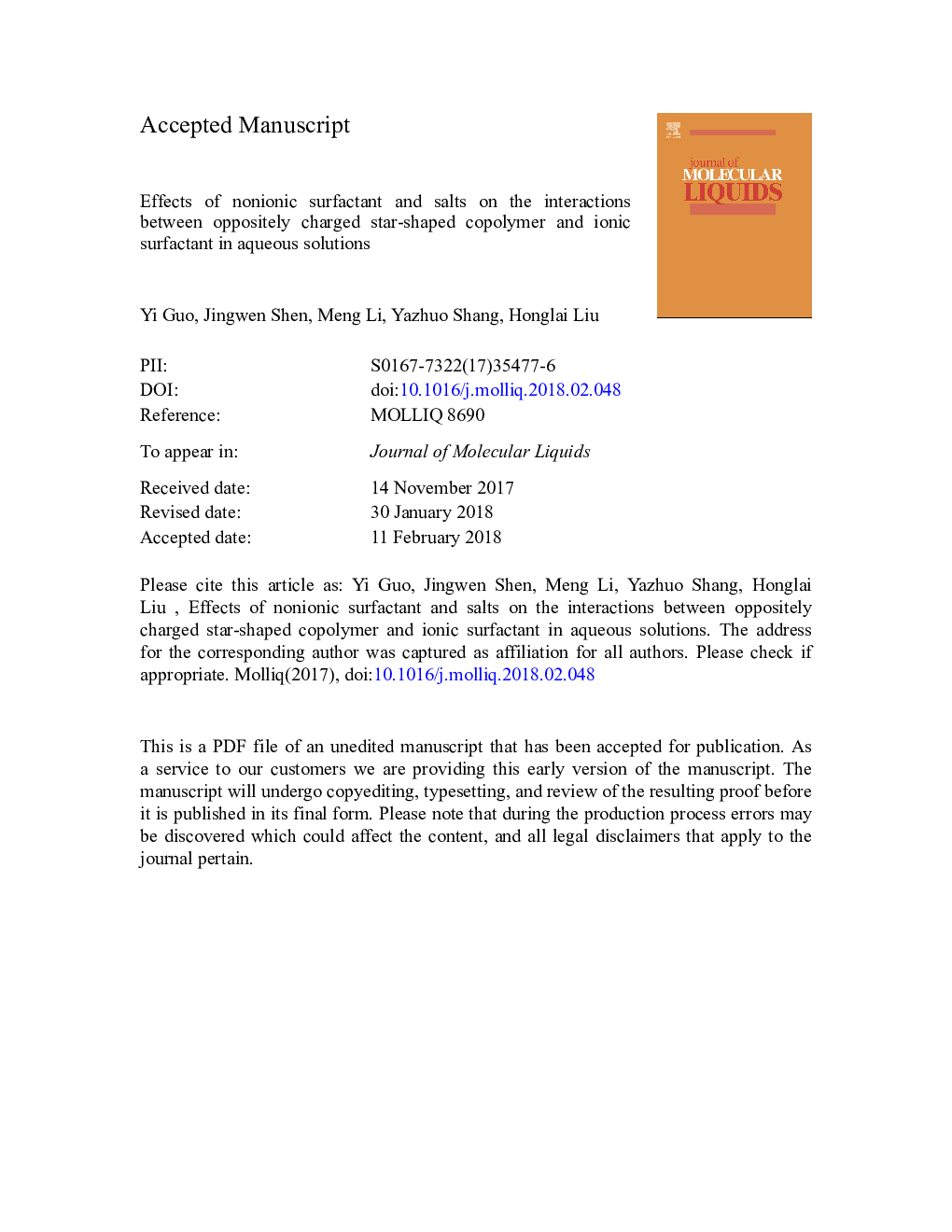| کد مقاله | کد نشریه | سال انتشار | مقاله انگلیسی | نسخه تمام متن |
|---|---|---|---|---|
| 7841978 | 1506505 | 2018 | 25 صفحه PDF | دانلود رایگان |
عنوان انگلیسی مقاله ISI
Effects of nonionic surfactant and salts on the interactions between oppositely charged star-shaped copolymer and ionic surfactant in aqueous solutions
ترجمه فارسی عنوان
اثرات سورفکتانت غیر معدنی و نمک بر تعاملات متقابل متشکل از کوپلیمر ستاره ای و سورفاکتانت یونی در محلول های آبی
دانلود مقاله + سفارش ترجمه
دانلود مقاله ISI انگلیسی
رایگان برای ایرانیان
کلمات کلیدی
کوپلیمر ستاره ای سورفاکتانت، اثر متقابل، حرارتی حساس، نمک،
موضوعات مرتبط
مهندسی و علوم پایه
شیمی
شیمی تئوریک و عملی
چکیده انگلیسی
The interaction between star-shaped copolymer poly(2-(dimethylamino)ethyl methacrylate-b-2-(2-methoxyethoxy)ethyl methacrylate) (CDPDPM) and anionic surfactant sodium dodecyl sulfate (SDS) in aqueous solutions are investigated by using fluorescence and dynamic light scattering (DLS) techniques. The effects of nonionic surfactant dodecyl β-D-maltopyranoside (C12G2) and salts including inorganic salt ammonium bromide (NH4Br) and organic salt tetra-n-butylammonium bromide (Bu4NBr) on the interaction between CDPDPM and SDS have been explored systematically. The results have suggested that SDS molecules can bind on CDPDPM by electrostatic interaction between the positively charged CDPDPM and negatively charged SDS and thus weaken the binding ability of CDPDPM to water molecules. CDPDPM exhibits temperature-responsive aggregation behavior in aqueous solution gradually with the increase of SDS concentration and the lower critical solution temperature (LCST) decreases correspondingly. The introduction of nonionic surfactant C12G2 changes the interaction between CDPDPM and SDS significantly by participate the formation of complexes and the stability of the CDPDPM/SDS complexes declines leading to the chance of forming larger complexes is deprived at higher temperature. The addition of NH4Br to the CDPDPM/SDS system can retard the binding of SDS on the polymer chains because of electrostatic shielding. Correspondingly, LCST is higher and the formed aggregates are smaller. For CDPDPM/Bu4NBr/SDS system, the phenomenon is similar to that of the CDPDPM/C12G2/SDS system. This should be attributed to the nature of Bu4N+, possesses not only positive charges but also certain hydrophobicity, and thus Bu4N+ has the ability to participate and facilitate the formation of SDS micelles. Obviously, the LCST of the mixed system can be tailored by adjusting the system composition on purpose.
ناشر
Database: Elsevier - ScienceDirect (ساینس دایرکت)
Journal: Journal of Molecular Liquids - Volume 266, 15 September 2018, Pages 789-796
Journal: Journal of Molecular Liquids - Volume 266, 15 September 2018, Pages 789-796
نویسندگان
Yi Guo, Jingwen Shen, Meng Li, Yazhuo Shang, Honglai Liu,
